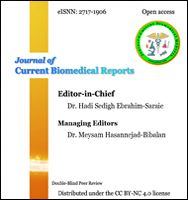Evaluation of the antibacterial effect of nickel oxide nanoparticles against bacteria involved in dental caries
Abstract
Tooth decay is one of the most common diseases in the oral cavity and is one of the most widespread diseases in the human population. This study aimed to determine the antibacterial effect of nickel oxide nanoparticles against bacteria involved in tooth decay. In this study, the disk diffusion method was used to determine the antibiotic susceptibility and the microdilution broth method was used to determine the minimum inhibitory concentration (MIC). Nanoparticles were also synthesized in two molecular size (A: 8.1 and B: 12 nm) by the sol-gel method. The MIC of the first nanoparticle for Streptococcus sanguinis and Streptococcus mutans was 31.25 and 125 μg/ml, respectively. The MIC of the second nanoparticle for S. sanguinis was 125 μg/ml. In the case of S. mutans up to a concentration of 500 μg/ml, no growth inhibition was observed. The results showed that nickel oxide nanoparticles have acceptable antibacterial properties against S. mutans and S. sanguinis, which can be used in dental materials to prevent dental caries. However, this requires the determination of cellular toxicity and its side effects in future studies.
Keywords
Full Text:
Full-text PDFReferences
Allaker RP, Memarzadeh K. Nanoparticles and the control of oral infections. Int J Antimicrob Agents. 2014;43(2):95-104.
Song W, Ge S. Application of antimicrobial nanoparticles in dentistry. Molecules. 2019;24(6):1033.
Costerton JW, Cheng KJ, Geesey GG, Ladd TI, Nickel JC, Dasgupta M, et al. Bacterial biofilms in nature and disease. Annu Rev Microbiol. 1987;41(1):435-64.
Lemos JA, Palmer SR, Zeng L, Wen ZT, Kajfasz JK, Freires IA, et al. The Biology of Streptococcus mutans. Microbiol Spectr. 2019;7(1):1-18.
Napimoga MH, Kamiya RU, Rosa RT, Rosa EA, Höfling JF, de Oliveira Mattos-Graner R, et al. Genotypic diversity and virulence traits of Streptococcus mutans in caries-free and caries-active individuals. J Med Microbiol. 2004;53(Pt 7):697-703.
Krzyściak W, Jurczak A, Kościelniak D, Bystrowska B, Skalniak A. The virulence of Streptococcus mutans and the ability to form biofilms. Eur J Clin Microbiol Infect Dis. 2014;33(4):499-515.
Caufield PW, Dasanayake AP, Li Y, Pan Y, Hsu J, Hardin JM. Natural history of Streptococcus sanguinis in the oral cavity of infants: evidence for a discrete window of infectivity. Infect Immun. 2000;68(7):4018-23.
Gross EL, Beall CJ, Kutsch SR, Firestone ND, Leys EJ, Griffen AL. Beyond Streptococcus mutans: dental caries onset linked to multiple species by 16S rRNA community analysis. PLoS One. 2012;7(10):e47722.
Seoudi N, Bergmeier LA, Drobniewski F, Paster B, Fortune F. The oral mucosal and salivary microbial community of Behçet's syndrome and recurrent aphthous stomatitis. J Oral Microbiol. 2015;7:27150.
Yoshida Y, Konno H, Nagano K, Abiko Y, Nakamura Y, Tanaka Y, et al. The influence of a glucosyltransferase, encoded by gtfP, on biofilm formation by Streptococcus sanguinis in a dual-species model. APMIS. 2014;122(10):951-60.
Zhu B, Ge X, Stone V, Kong X, El-Rami F, Liu Y, et al. ciaR impacts biofilm formation by regulating an arginine biosynthesis pathway in Streptococcus sanguinis SK36. Sci Rep. 2017;7(1):17183.
Jeevanandam J, Barhoum A, Chan YS, Dufresne A, Danquah MK. Review on nanoparticles and nanostructured materials: history, sources, toxicity and regulations. Beilstein J Nanotechnol. 2018;9:1050-74.
Amiri M, Etemadifar Z, Daneshkazemi A, Nateghi M. Antimicrobial Effect of Copper Oxide Nanoparticles on Some Oral Bacteria and Candida Species. J Dent Biomater. 2017;4(1):347-52.
Nozari A, Ajami S, Rafiei A, Niazi E. Impact of Nano Hydroxyapatite, Nano Silver Fluoride and Sodium Fluoride Varnish on Primary Teeth Enamel Remineralization: An In Vitro Study. J Clin Diagn Res. 2017;11(9):ZC97-ZC100.
Noori AJ, Kareem FA. The effect of magnesium oxide nanoparticles on the antibacterial and antibiofilm properties of glass-ionomer cement. Heliyon. 2019;5(10):e02568.
Imran Din M, Rani A. Recent Advances in the Synthesis and Stabilization of Nickel and Nickel Oxide Nanoparticles: A Green Adeptness. Int J Anal Chem. 2016;2016:3512145.
Zorkipli NN, Kaus NH, Mohamad AA. Synthesis of NiO Nanoparticles through Sol-gel Method. Procedia Chem. 2016;19:626-31.
Nanda A, Saravanan M. Biosynthesis of silver nanoparticles from Staphylococcus aureus and its antimicrobial activity against MRSA and MRSE. Nanomedicine. 2009;5(4):452-6.
Wayne PA. Performance Standards for Antimicrobial Susceptibility Testing. Clinical and Laboratory Standards Institute (CLSI) 2022; 32th Informational Supplement. (M100-S28).
Khodaee S, Sadeghi R, Taleghani F, Mahboubi A, Shafaei Mobarakeh A. In Vitro Assessment of Anti-Bacterial and Anti-Biofilm Effects of Nanosilver Solution on Dental Plaque Microorganisms. J Mashhad Dent Sch. 2020;44(2):114-26.
Emrani S, Zhiani R, Dafe Jafari M. The biosynthesis of silver nanoparticles using plants of Glycyrrhiza glabra and Mentha piperata and its antimicrobial effect on some bacterias that cause tooth decay. J Rafsanjan Univ Med Sci. 2018;16(10):953-68.
Vahid Dastjerdi E, Abdolazimi Z, Ghazanfarian M, Amdjadi P, Kamalinejad M, Mahboubi A. Effect of Punica granatum L. Flower Water Extract on Five Common Oral Bacteria and Bacterial Biofilm Formation on Orthodontic Wire. Iran J Public Health. 2014;43(12):1688-94.
Sadeghi R, Owlia P, Taleghani F, Sharif F. An in-vitro comparison between antimicrobial activity of nanosilver and chlorhexidine against Streptococus sanguinis and Actinomyces viscosus. J Iran Dent Assoc. 2011;23(4):225-31.
Lu Z, Rong K, Li J, Yang H, Chen R. Size-dependent antibacterial activities of silver nanoparticles against oral anaerobic pathogenic bacteria. J Mater Sci Mater Med. 2013;24(6):1465-71.
Aflatoonian M, Khatami M, Sharifi I, Pourseyedi S, Yaghobi H, Naderifar M. Evaluation antimicrobial activity of biogenic zinc oxide nanoparticles on two standard gram positive and gram negative strains. Tehran Univ Med J. 2017;75(8):562-9.
Davari A, Mosaddegh A, Daneshkazemi A, Mortazavi Sanigei SM. Comparison of Antibacterial Effect of Composite Resins Incorporating Copper with Zinc Oxide Nanoparticles on Streptococcus Mutans. J Mashhad Dent Sch. 2020;43(4):344-51.
Refbacks
- There are currently no refbacks.
Copyright (c) 2022 © The Author(s)

This work is licensed under a Creative Commons Attribution-NonCommercial 4.0 International License.













